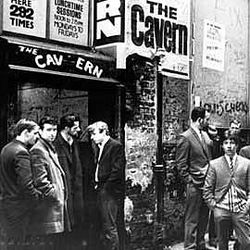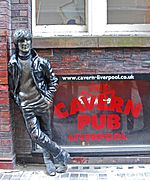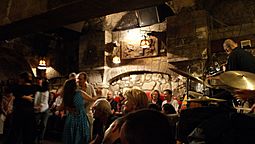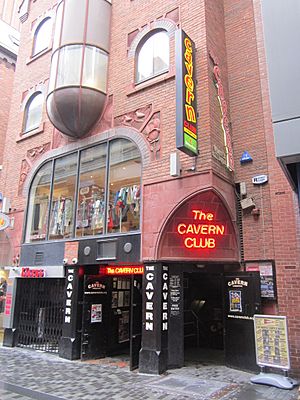The Cavern Club facts for kids

The original Cavern Club entrance in 1963.
|
|
| Location | Mathew Street, Liverpool, England, United Kingdom |
|---|---|
| Owner | Alan Sytner, Bob Wooler, Ray McFall, Tommy Smith, Bill Heckle, Dave Jones |
| Type | Music club |
| Genre(s) | Night club |
| Opened | 1957, reopened 1984 and 1991 |
| Closed | 1 March 1973, and 1989 |
The Cavern Club is a famous music venue located on Mathew Street in Liverpool, England.
It opened in 1957 as a jazz club. Soon, it became a very important place for rock and roll music in the early 1960s. The club is especially famous because the Beatles played there many times when they were just starting out.
The original Cavern Club closed in 1973. It was later rebuilt and reopened in 1984. Today, it's still a popular place for live music and a major tourist attraction.
The Cavern Club's Story
How the Cavern Club Started
The Cavern Club was opened by Alan Sytner. He was inspired by the jazz clubs he saw in Paris, France, which were often in cellars. Sytner wanted to create a similar club in Liverpool. He found a cellar that used to be a fruit warehouse and an air raid shelter during World War II.
The club first opened its doors on January 16, 1957. The first band to play there was the Merseysippi Jazz Band. A local artist named Tony Booth designed the posters for the opening night. He later became the first poster artist for the Beatles.
From Jazz to Skiffle and Rock 'n' Roll
The Cavern Club began as a jazz club. However, it soon became a popular spot for skiffle groups. Skiffle was a type of music that mixed jazz, blues, and folk, often played with homemade instruments.
One day, a young man named Nigel Walley asked Alan Sytner if his band, The Quarrymen, could play at the club. The Quarrymen were a skiffle group that included John Lennon and Paul McCartney. They played their first show at The Cavern on August 7, 1957.
During that first performance, the band was supposed to play only skiffle. But John Lennon decided to play an Elvis Presley rock 'n' roll song, "Don't Be Cruel". The club owner, Alan Sytner, quickly gave Lennon a note telling him to "Cut out the bloody rock 'n' roll."
Paul McCartney first played at The Cavern with The Quarrymen on January 24, 1958. George Harrison later joined them, playing his first show at the club on February 9, 1961.
New Owners and New Music
In 1959, Alan Sytner sold The Cavern Club to Ray McFall. In the early 1960s, the club started featuring more blues and Beat groups. The first "Beat night" was held on May 25, 1960. It featured a band called Rory Storm and the Hurricanes, whose drummer was Ringo Starr.
By 1961, Bob Wooler became the club's full-time host and organized the popular lunchtime music sessions.
The Beatles' Rise to Fame

the Beatles played their first show at The Cavern Club on February 9, 1961. They had just returned to Liverpool after playing in Hamburg, Germany. Their performances had changed a lot, and some people even thought they were a German band!
From 1961 to 1963, The Beatles played at the club an amazing 292 times. Their very last performance there was on August 3, 1963. This was just a month after they recorded their hit song "She Loves You."
By this time, "Beatlemania" was sweeping across England. Girls were screaming to see The Beatles, and the small club could no longer hold all their fans. The band had become too big for the Cavern and soon signed with EMI's Parlophone label.
Other Famous Performers
After The Beatles, many other famous bands and artists played at The Cavern Club. These included The Rolling Stones, The Yardbirds, The Hollies, The Kinks, Elton John, Black Sabbath, Queen, The Who, and John Lee Hooker.
Even future star Cilla Black worked at the club for a while, checking hats for visitors.
Why the Original Club Closed
The Cavern Club closed in March 1973. This happened because British Rail bought the warehouses above the club. They planned to build a ventilation shaft for a new underground railway called Merseyrail. However, the shaft was never built, and the area became a car park.
The Cavern Club Today
After the original club closed, a new Cavern Club opened nearby on Mathew Street. This new club later became known as Erics, which was also a famous music spot in the late 1970s.
In 1981, there were plans to dig up the remains of the original Cavern Club cellar. But in 1982, it was announced that the old cellar was too damaged to be reopened.
To help raise money, 5,000 bricks from the damaged original cellar were sold for £5 each. The money went to a children's home. Later, 15,000 more bricks from the original site were used to help rebuild the new Cavern Club.
Reopening and New Owners
The Cavern Club that stands today is built at a 90-degree angle to the original. It covers about 70% of the original club's space. The stage is close to where the original one was, and the "Live Lounge" looks exactly like the old club.
The club was taken over by former Liverpool F.C. player Tommy Smith. However, it faced money problems and closed for 18 months in 1989.
In 1991, two friends, Bill Heckle and Dave Jones, reopened the club with George Guinness. They are now the longest-running owners in the club's history. The Cavern Club continues to be a popular live music venue. It plays music from the 1960s, 1970s, 1980s, and 1990s, as well as modern pop, indie, and rock.
Famous Performances Today
On December 14, 1999, former Beatle Paul McCartney played a special show at the new Cavern Club to promote his album Run Devil Run.
Today, about 40 live bands perform there every week. These include tribute bands and original bands. The back room of the Cavern often hosts touring acts and ticketed events. Famous artists like The Wanted, Adele, and Jessie J have played there. It's also a place where big bands like the Arctic Monkeys, Jake Bugg, Travis, and Oasis sometimes play secret warm-up gigs.
The front room is a big draw for tourists. People love to take photos on the stage, with the names of all the bands who played there written on the back wall. Live music plays in this room from noon until late every day.
In 2017, the Cavern Club asked Tony Booth, who designed the original posters, to create artwork for its 60th anniversary. This artwork shows many bands and musicians who performed at the club. Also in 2017, a statue of Cilla Black was placed outside the original entrance.
On June 26, 2018, Paul McCartney returned to the Cavern Club for another surprise concert. He played for two hours, opening the show by saying, "Liverpool! Cavern! These are words that go together well!"
Tributes to The Cavern Club
The Cavern Club is so famous that other clubs inspired by it have opened in places like Dallas, Buenos Aires, Wellington, and Lanzarote. There were also clubs in Tokyo and Adelaide.
The movie Across the Universe features a club that looks like The Cavern in its opening scene. This part of the movie was actually filmed inside the real Cavern Club. The Cavern Club is also the first place you can play in the video game The Beatles: Rock Band.
The Hard Rock Cafe chain even has the right to use the "Cavern Club" name in the US. Some of their restaurants have areas designed to look like the Cavern.
The club has also appeared in movies about John Lennon, like In His Life: The John Lennon Story (2000) and Nowhere Boy (2009).
Norwegian Cruise Lines also has Cavern Clubs on two of their ships, the Norwegian Bliss and the Norwegian Epic. These clubs feature bands that play tribute to The Beatles.
See also
 In Spanish: Cavern Club para niños
In Spanish: Cavern Club para niños





